By Dr. Ken Broda Bahm:
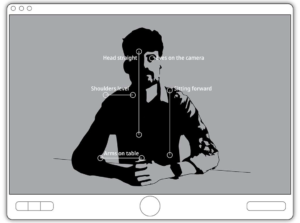
If you’re like me, you have been clicking into a ton of web-conferences lately. That’s true of the whole business world, but I think the legal workplace is a natural fit for web conferencing. After all, it is a field that is based on giving advice, so if we’re under a stay-at-home order, let’s go ahead and meet online. Recently, I have written about variety of communication considerations on these web-conferences, whether you’re testifying, mediating, or just meeting, there are a number of best practices to keep in mind. But there is one I want to return to, because it is becoming increasingly clear that it is the original sin of web-conferenced communication: camera position. Nothing looks good if your camera position is poor, and on my screen at least, it is shockingly common for web-conference participants to give little thought to it.
It may be that there is a perceived informality to a web conference that lulls us into the view that the visuals don’t really matter that much: It is like a phone call, but with a camera on. I would argue that in contrast, it is like attending a meeting in person. You know that folks will be seeing you, so you want to look prepared, competent, credible. And you want to demonstrate respect by showing that, if it’s important enough to be on camera, then it is important enough to give some thought to what the camera shows. Self-presentation matters. And good self-presentation starts with a good camera position. In this post, I will share and show six golden rules for setting the camera position.
1. Don’t Look Down on Your Camera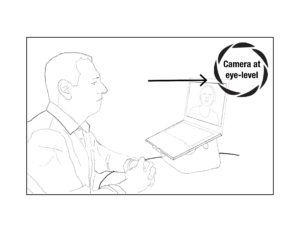
This is the truly big one that drives me nuts. Many to most on the web-conference will simply sit in front of their laptop, open it up and lean their screen way back so the camera focuses on their face. But the result is that the camera is at close-range looking up at a 45-degree angle. Facial features are foreshortened, and it is just an odd view. And, yes, we can see up your nostrils. There is a reason that most conversations occur with both people standing or both people sitting — looking down to talk to someone seems odd, or even arrogant. We want to be eye-to-eye. So, the solution is to raise your laptop’s camera to eye level. Keep a box next to your desk, and when it is time for the web call, simply put your laptop on top of the box. Your shot will be far better.
2. Don’t Look Somewhere Other Than Your Camera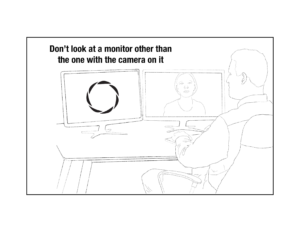
These days, many of us have multiple monitors. It is great — I have three external monitors in my office — and it is helpful to put different work in different places. That set-up, however, can wreak havoc with your web-conference if the screen you are looking at is not the screen that includes the camera. We’ll end up seeing the side of your face, and you’ll spend the conference looking like you are part of some other conference, and not speaking with us. So make the screen you’re watching and the screen with the camera the same screen. Most web-conferencing software will default to running the conference on whatever your system considers to be your “primary” monitor. But you can drag that window elsewhere. So before you click the “Join” button, move things around so that you’ve got your conference and your camera on the same screen.
3. Seek Out Plenty of Light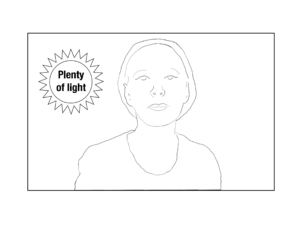
Any photographer will tell you: Light is everything the lens has to work with. And a good reminder is that the camera requires more light than the human eye does – a situation that looks fine to you in person can often look dark and undefined on the camera. If you have a home office with windows, or even an outdoor workspace, put that to good use. Natural light is often going to be best for creating a vivid and well-lit shot without creating shadows on your face. But, if you use indoor lighting, pay attention to where the light is and where the shadows are. Avoid a light source that seems to provide light from only one direction. You don’t need the professional klieg lights, but you do want to give some thought and some trial and error to see how it looks on screen.
4. Don’t Lose Yourself in Backlight
In particular, don’t point the camera at a window with you in front of a window. Even a little bit of backlighting can cast you in deep shadow. Again, it is important to remember that the camera is different from the human eye. Based on your own view, it may not seem like the light coming from a window is particularly bright, but a camera facing the light will make its own automatic adjustments, and that can mean casting your face into deep shadows, making it difficult or impossible to see your expressions. Better to arrange the camera so that the light source is behind it. That way, you benefit from the illumination, but without the light’s source being present in the frame.
5. Mostly Fill the Frame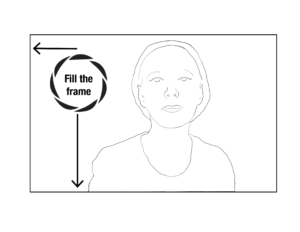
Another practical consideration in camera placement is how much of you should fit in the frame. You don’t need an extreme close up, but you do want that frame to mostly consist of you. Think about when a broadcast news camera focuses on a single commentator — that is the shot you want. It is also similar to what we most often see in a video-recorded deposition. While sitting straight up with your forearms in front of you, you should see your head, shoulders, and part of your chest.
6. Think About Your Background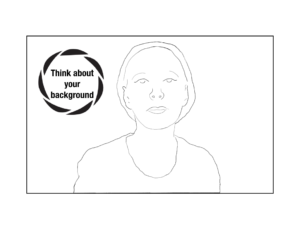
In addition to you, think about everything in the frame. If you’re testifying, then chances are you want there to be, other than you, nothing but a neutral wall or background. But if you’re just participating in a meeting, there is no reason that you can’t show a bit of your home. Make it something nice and non-distracting. A bookshelf, fireplace, lamp, etc., and make sure it is neat. Think about it this way: It is as if people are coming to your home, but they’re not going to wander around in your whole home, they’re just going to be in one room. And even in that room, they are only going to look in one direction. As this New Yorker cartoon helpfully illustrates, that makes it easier. With the scope narrowed to just that, surely you can make sure that that one direction in one room actually reflects well on you and your home.
______
Other Posts on Video-recorded Communication:
- Adapt to Remote Communication (Including Testimony)
- Remember that the Camera Has a Bias
- Avoid Gaze Aversion in Your Deposition Video